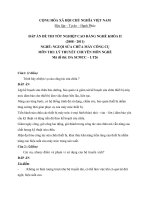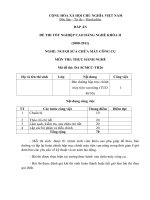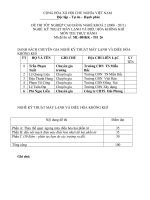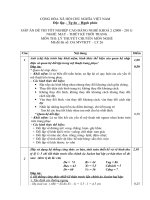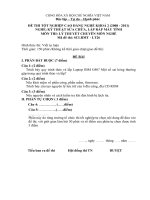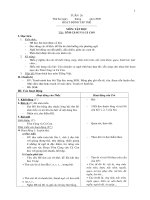Lecture Connections 26 | RNA Metabolism
Bạn đang xem bản rút gọn của tài liệu. Xem và tải ngay bản đầy đủ của tài liệu tại đây (2.12 MB, 51 trang )
Lecture Connections
26 | RNA Metabolism
© 2009 W. H. Freeman and Company
CHAPTER 26
RNA Metabolism
Key topics:
– Transcription: DNA-dependent synthesis of RNA
– Capping and splicing: RNA processing
Overview of RNA Function
• Ribonucleic acids play three well-understood roles in
living cells
– Messenger RNAs encode the amino acid sequences of all the
polypeptides found in the cell
– Transfer RNAs match specific amino acids to triplet codons in
mRNA during protein synthesis
– Ribosomal RNAs are the constituents and catalytic appropriate
amino acid
• Ribonucleic acids play several less-understood
functions in eukaryotic cells
– Micro RNA appears to regulate the expression of genes,
possibly via binding to specific nucleotide sequences
• Ribonucleic acids act as genomic material in viruses
Overview of RNA Metabolism
• Ribonucleic acids are synthesized in cells using DNA as
a template in a process called the transcription
– Transcription is tightly regulated in order to control the
concentration of each protein in the cell at optimal level
• Being mainly single stranded, many RNA molecules can
fold into compact structures with specific functions
– Some RNA molecules can act as catalysts (ribozymes), often
using metal ions as cofactors
• Most eukaryotic ribonucleic acids are processed after
synthesis
– Elimination of introns; joining of exons
– Poly-adenylation of the 3’ end
– Capping the 5’ end
Transcription in E. coli
• The nucleoside triphosphates add to the the 3’
end of the growing RNA strand
• The growing chain is complementary to the
template strand in DNA
• The synthesis is catalyzed by enzyme (RNA
polymerase)
• RNA polymerase covers about 35 bp-long
segment of DNA
Replication vs. Transcription
• Both add nucleotides via an attack of the 3’ hydroxyl of the
growing chain to -phosphorus of nucleoside triphosphates
– RNA synthesis requires ribonucleoside triphosphates
– RNA synthesis pairs A with U instead of dA with dT
• Both require catalysis by a Mg++-dependent enzyme
– RNA synthesis has lower fidelity
– RNA synthesis does not require a primer for initiation
• Both require a single strand of DNA as molecular template
for building the new strand
Both DNA Strands may Encode for
Proteins
• Adenovirus is one of the causative agents of
common cold
• Adenovirus has a linear genome
• Each strand encodes for a number of proteins
RNA Synthesis is Catalyzed by the
RNA Polymerase
• Mg++ on the right coordinates to the -phosphate
and stabilizes the negatively charged transition
state
Movement of RNA Polymerase
Causes Local Supercoiling
• Positive supercoils (overwound) ahead of the
bubble
• Negative supercoils (underwound) behind the
bubble
• Topoisomerase eliminates positive supercoils
Bacterial RNA Polymerase has at
Least Six Subunits
• Two two subunits function in assembly and
binding to UP elements
• The subunit is the main catalytic subunit
• The ’ subunit is responsible for DNA-binding
• The subunit directs enzyme to the promoter
• The appears to protect the polymerase from
denaturation
The Subunit Binds to Promoter
Sequences in DNA
• Typical promoters have TATA sequence about 10
base pairs before the transcription starts side
• AT-rich sequences promote strand separation
during initiation
Subunit Determines the Types
of Genes Expressed
Transcription Initiation and
Elongation in E. coli
• In the closed complex, the DNA in the promoter
region is bound to polymerase but not unwound
• In the open complex, the two chains in the ATrich promoter region region are separated
• subunit leaves before elongation starts
-Independent Termination of
Transcription in Prokaryotes
• The RNA polymerase pauses at certain
sequences during transcription
• Some sequences allow formation of the hairpin
within the product
• If the polymerase pauses for long enough and
the hairpin forms, the RNA-DNA hybrid is
disrupted
• This promotes dissociation of the polymerase
Eukaryotes Contain Several
Distinct Polymerases
• RNA polymerase I synthesizes pre-ribosomal RNA
(precursor for 28S, 18S, and 5.8 rRNAs)
• RNA polymerase II is responsible for synthesis of mRNA
– Very fast (500 – 1000 nucleotides / sec)
– Specifically inhibited by mushroom toxin -amanitin
• RNA polymerase III makes tRNAs and some small RNA
products
• Plants appear to have RNA polymerase IV that is
responsible for the synthesis of small interfering RNAs
• Mitochondria have their own RNA polymerase
